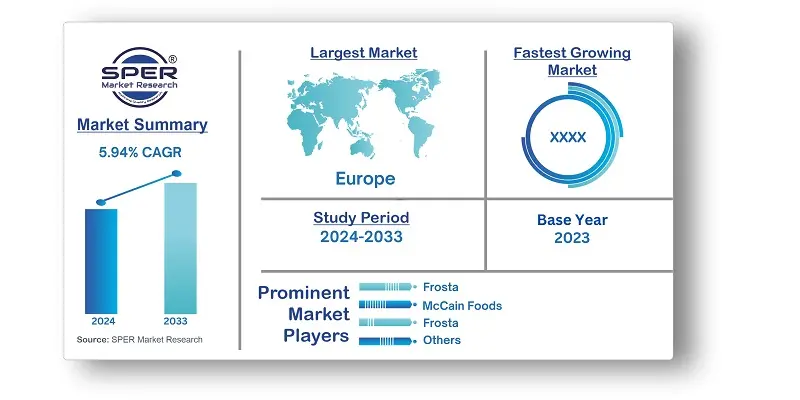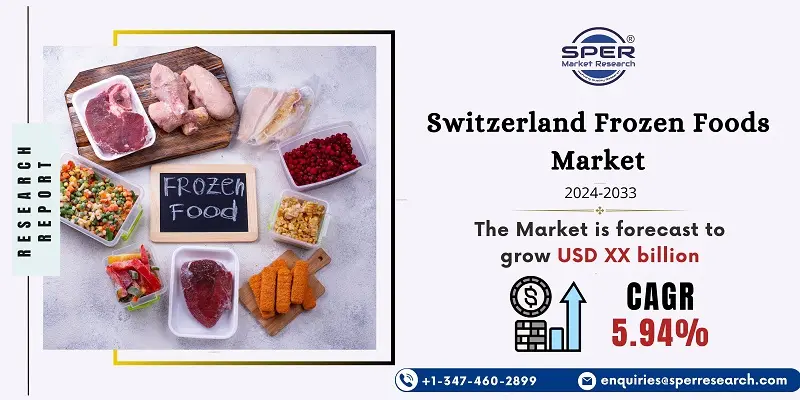
Switzerland Frozen Foods Market Trends, Share, Size, Demand, Revenue and Future Outlook
Switzerland Frozen Foods Market Growth, Size, Trends Analysis- By Product Type, By Distribution Channel, By End User- Regional Outlook, Competitive Strategies and Segment Forecast to 2033
| Published: Oct-2024 | Report ID: FOOD24105 | Pages: 1 - 106 | Formats*: |
| Category : Food & Beverages | |||
- Vegan fish fingers were among the new plant-based frozen snacks that Frosta AG, a major leader in the European frozen food market, announced in 2023. This action is a component of the business's larger aim to profit from the rising demand for sustainable and plant-based food goods.

- lower perception of quality: Some customers think frozen meals are of lower quality or less healthful than those made fresh. The market's acceptance is constrained by this notion, especially among health-conscious consumers.
- Environmental Concerns: Greenhouse gas emissions, packaging waste, and energy usage during freezing processes are all associated with the production and delivery of frozen food. These problems may make it more difficult for the frozen food industry to grow.
- Trends in Nutrition and Health: Consumers who are increasingly health-conscious are gravitating toward fresh, minimally processed meals over frozen ones they perceive to be heavily processed or loaded with additives.
- Choice for Fresh Foods: In certain market segments, customer preference for fresh foods, especially in areas like fruits and vegetables, limits the development potential of frozen substitutes.

| Report Metric | Details |
| Market size available for years | 2020-2033 |
| Base year considered | 2023 |
| Forecast period | 2024-2033 |
| Segments covered | By Product Type, By Distribution Channel, By End User. |
| Regions covered | Eastern Region, Western Region, Northern Region, Southern Region. |
| Companies Covered | Nestlé S.A, Iglo, Frosta, Mövenpick, McCain Foods, Others. |
- Retail Consumers
- Food Service Providers
- Wholesale Distributors
- Restaurants and Cafés
- Meal Kit Companies
- Supermarkets and Grocery Chains
- Health-Conscious Consumers
| By Product Type: | |
| By Distribution Channel: | |
| By End Use: |
- Switzerland Frozen Foods Market Size (FY’2024-FY’2033)
- Overview of Switzerland Frozen Foods Market
- Segmentation of Switzerland Frozen Foods Market By Product Type (Poultry, Beef, Pork, Seafood, Others)
- Segmentation of Switzerland Frozen Foods Market By Distribution Channel (Supermarkets and Hypermarkets, Convenience Stores, Online, Others)
- Segmentation of Switzerland Frozen Foods Market By End Use (Retail, Institutional)
- Expansion Analysis of Switzerland Frozen Foods Market
- Problems and Obstacles in Switzerland Frozen Foods Market
- Competitive Landscape in the Switzerland Frozen Foods Market
- Impact of COVID-19 and Demonetization on Switzerland Frozen Foods Market
- Details on Current Investment in Switzerland Frozen Foods Market
- Competitive Analysis of Switzerland Frozen Foods Market
- Prominent Players in the Switzerland Frozen Foods Market
- SWOT Analysis of Switzerland Frozen Foods Market
- Switzerland Frozen Foods Market Future Outlook and Projections (FY’2024-FY’2033)
- Recommendations from Analyst
1.1. Scope of the report1.2. Market segment analysis
2.1. Research data source
2.1.1. Secondary Data2.1.2. Primary Data2.1.3. SPER internal database2.1.4. Premium insight from KOLs
2.2. Market size estimation
2.2.1. Top-down and Bottom-up approach
2.3. Data triangulation
4.1. Driver, Restraint, Opportunity and Challenges analysis
4.1.1. Drivers4.1.2. Restraints4.1.3. Opportunities4.1.4. Challenges
4.2. COVID-19 Impacts of the Switzerland Frozen Foods Market
5.1. SWOT Analysis
5.1.1. Strengths5.1.2. Weaknesses5.1.3. Opportunities5.1.4. Threats
5.2. PESTEL Analysis
5.2.1. Political Landscape5.2.2. Economic Landscape5.2.3. Social Landscape5.2.4. Technological Landscape5.2.5. Environmental Landscape5.2.6. Legal Landscape
5.3. PORTER’s Five Forces
5.3.1. Bargaining power of suppliers5.3.2. Bargaining power of buyers5.3.3. Threat of Substitute5.3.4. Threat of new entrant5.3.5. Competitive rivalry
5.4. Heat Map Analysis
6.1. Switzerland Frozen Foods Market Manufacturing Base Distribution, Sales Area, Product Type6.2. Mergers & Acquisitions, Partnerships, Product Launch, and Collaboration in Switzerland Frozen Foods Market
7.1. Switzerland Frozen Foods Market Size, Share and Forecast, By Product Type, 2020-20267.2. Switzerland Frozen Foods Market Size, Share and Forecast, By Product Type, 2027-20337.3. Poultry7.4. Beef7.5. Pork7.6. Seafood7.7. Others
8.1. Switzerland Frozen Foods Market Size, Share and Forecast, By Distribution Channel, 2020-20268.2. Switzerland Frozen Foods Market Size, Share and Forecast, By Distribution Channel, 2027-20338.3. Supermarkets and Hypermarkets8.4. Convenience Stores8.5. Online8.6. Others
9.1. Switzerland Frozen Foods Market Size, Share and Forecast, By End Use, 2020-20269.2. Switzerland Frozen Foods Market Size, Share and Forecast, By End Use, 2027-20339.3. Retail9.4. Institutional
10.1. Switzerland Frozen Foods Market Size and Market Share
11.1. Switzerland Frozen Foods Market Size and Market Share By Region (2020-2026)11.2. Switzerland Frozen Foods Market Size and Market Share By Region (2027-2033)11.3. Eastern Region11.4. Western Region11.5. Northern Region11.6. Southern Region
12.1. Nestle S.A
12.1.1. Company details12.1.2. Financial outlook12.1.3. Product summary12.1.4. Recent developments
12.2. Iglo
12.2.1. Company details12.2.2. Financial outlook12.2.3. Product summary12.2.4. Recent developments
12.3. Frosta
12.3.1. Company details12.3.2. Financial outlook12.3.3. Product summary12.3.4. Recent developments
12.4. Movenpick
12.4.1. Company details12.4.2. Financial outlook12.4.3. Product summary12.4.4. Recent developments
12.5. McCain Foods
12.5.1. Company details12.5.2. Financial outlook12.5.3. Product summary12.5.4. Recent developments
12.6. Others
SPER Market Research’s methodology uses great emphasis on primary research to ensure that the market intelligence insights are up to date, reliable and accurate. Primary interviews are done with players involved in each phase of a supply chain to analyze the market forecasting. The secondary research method is used to help you fully understand how the future markets and the spending patterns look likes.
The report is based on in-depth qualitative and quantitative analysis of the Product Market. The quantitative analysis involves the application of various projection and sampling techniques. The qualitative analysis involves primary interviews, surveys, and vendor briefings. The data gathered as a result of these processes are validated through experts opinion. Our research methodology entails an ideal mixture of primary and secondary initiatives.



Frequently Asked Questions About This Report
PLACE AN ORDER
Year End Discount
Sample Report
Pre-Purchase Inquiry
NEED CUSTOMIZATION?
Request CustomizationCALL OR EMAIL US
100% Secure Payment






Related Reports
Our Global Clients
Our data-driven insights have influenced the strategy of 200+ reputed companies across the globe.




















